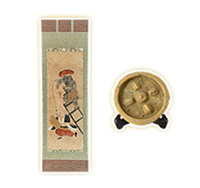

HOME ![]() About Tezukayama University
About Tezukayama University ![]() History
History
What follows is the history of Tezukayama University, from its foundation and development to the big leap it is about to take into the future.
| 1964 | Tezukayama University founded, with a single Department of Liberal Arts, Faculty of Liberal Arts. |
|
|---|---|---|
| 1982 | Tezukayama Archaeological Research Institute founded (from 1997 reorganized as Research Institute Archeology). | |
| 1988 | Department of Economics, Faculty of Economics founded. | |
| 1991 | Graduate School of Economics (Master’s Program) founded. | |
| 1993 |
Research Institute for Economics and Business founded.
Arts and Culture Research Institute, Tezukayama Educational Institution founded (from 2000 reorganized as Arts and Culture Research Institute of Tezukayama University, and from 2006 reorganized as Institute of Comprehensive Nara Cultural Studies of Tezukayama University)
Human Environmental Science Research Institute, Tezukayama Educational Institution founded (from 2000 reorganized as Human Environmental Science Research Institute of Tezukayama University).
|
|
| 1993 |
Department of Business Administration, Faculty of Economics founded.
Graduate School of Economics (Doctoral Program) established. |
|
| 1996 | Graduate School of Humanities (Master's Program) established. | |
| 1998 | Department of Law and Policy, Faculty of Law and Policy established. | |
| 2000 |
Department of Business Administration, Faculty of Business Administration founded.
Graduate School of Humanities (Doctral Program) established.
|
|
| 1999 | Tezukayama University’s Faculty of Liberal Arts reorganized as Faculty of Humanities and founded with a Department of Japanese Culture. Department of English Language and Culture and Department of Human Culture founded. |
|
| 2001 | Graduate School of Law and Policy (Master’s Program) established. | |
| 2003 | Graduate School of Law and Policy (Doctoral Program) established. | |
| 2004 | Department of Psychology, Department of Family and Consumer Welfare, Department of Food and Nutrition, and Department of Living Space Design established; Faculty of Psychology and Welfare founded.
Faculty of Contemporary Human Life Science founded. Museum of Tezukayama University founded. |
|
| 2005 | Tezukayama University Mental Care Center founded. | |
| 2006 | Department of Business Law and Department of Public Policy, Faculty of Law and Policy founded.
Tezukayama University founds training program for National Registered Dietitian qualification in Department of Food and Nutrition, Faculty of Contemporary Human Life Science.
Graduate School of Clinical and Social Psychology (Master’s Program) established. |
|
| 2009 | Department of Child Studies, Faculty of Contemporary Human Life Science founded. |
|
| 2010 | Tezukayama University’s Faculty of Law and Policy is reorganized as Faculty of Law with a single Department of Law. | |
| 2011 | Faculty of Psychology and Welfare is reorganized as Faculty of Psychological Sciences. | |
| 2012 | Graduate School of Clinical and Social Psychology (Master’s Course) is reorganized as Graduate School of Psychological Sciences (Master’s and Doctoral Courses). | |
| 2014 | Faculty of Humanities changes name to Faculty of Letters.
Department of English Communication of Faculty of Humanities is reorganized as Department of Culture and Creativity of Faculty of Letters. |
|
Rating and Accreditation of Tezukayama University

Rating and Accreditation by Japan University Accreditation Association
In April 2003, Tezukayama University was admitted to the Japan University Accreditation Association as a regular member, having met the university standards stipulated by the association. The university was again rated and accredited by the association in 2007 and 2014. The current period of accreditation lasts for seven years from April 2015 to March 2022.


